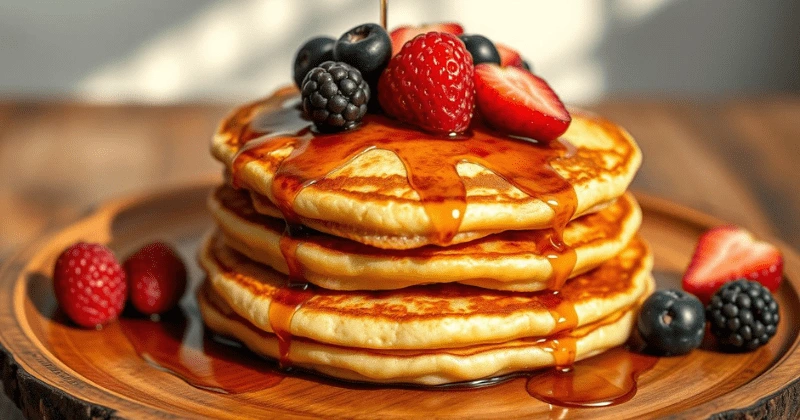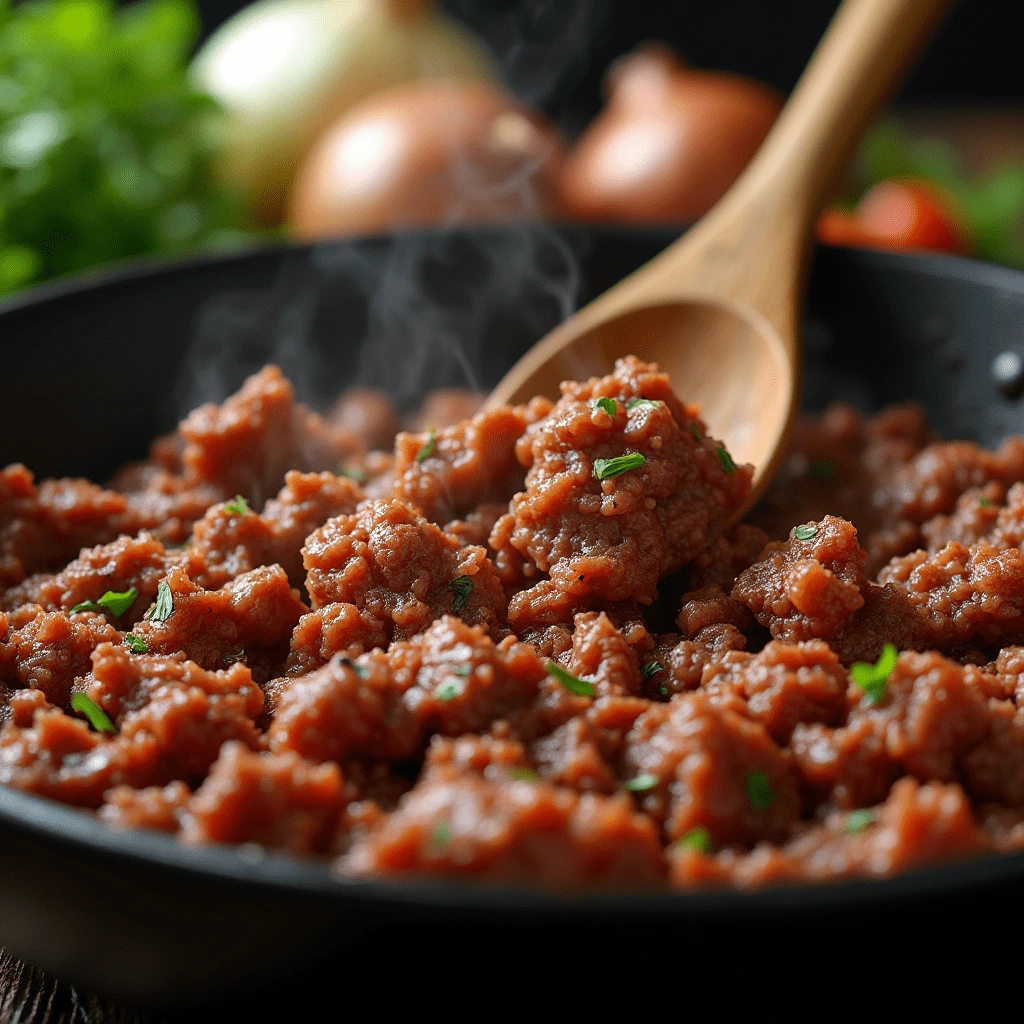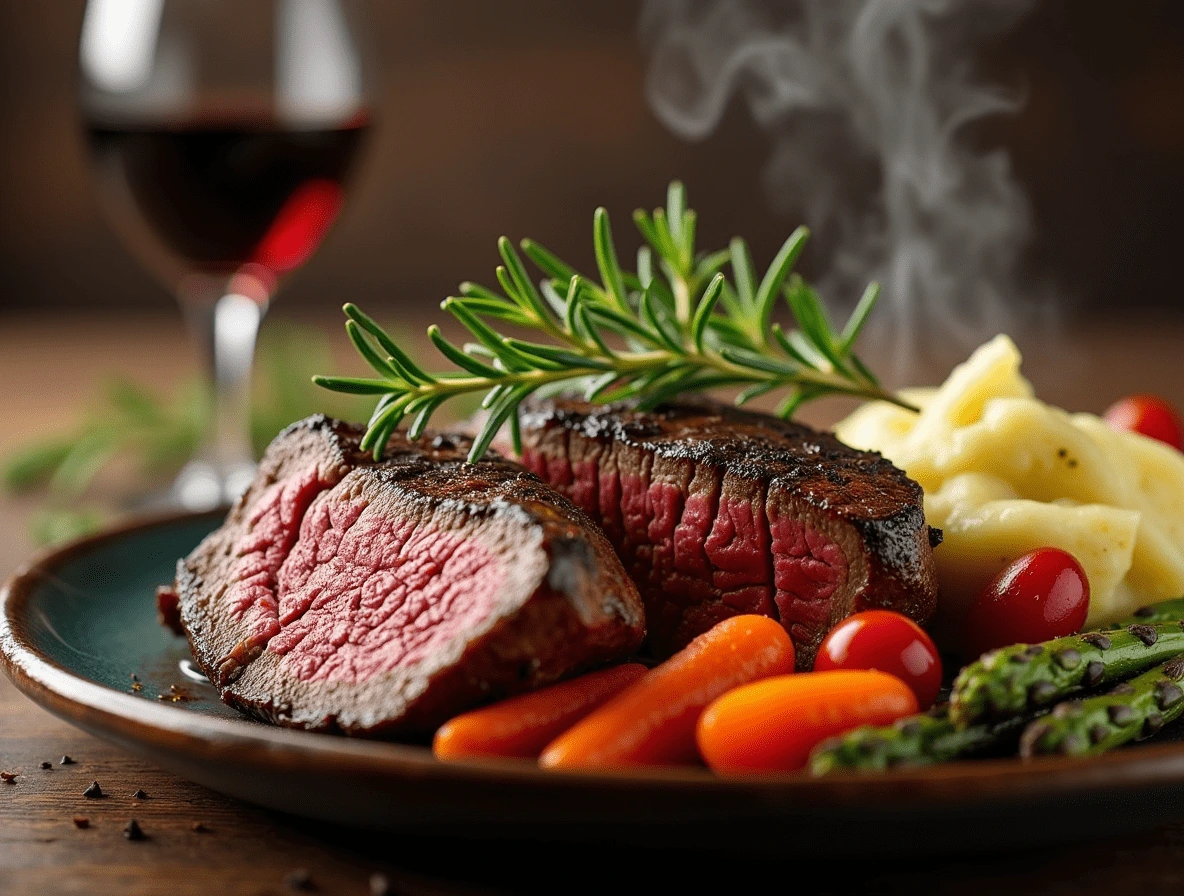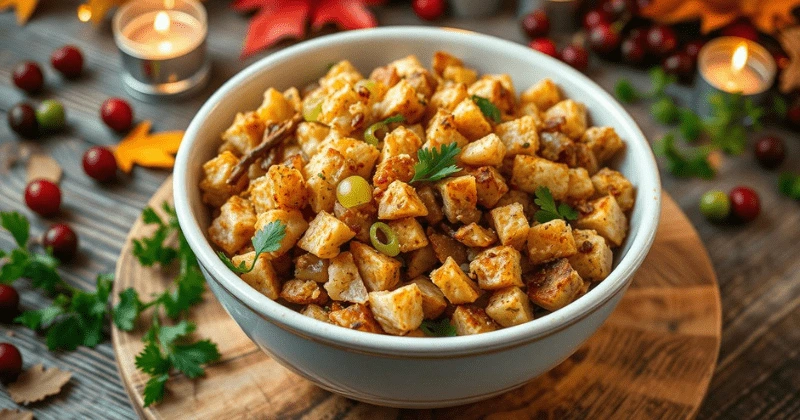The sun peeked through the curtains, and the kitchen filled with the smell of sourdough pancakes. It brought back memories of my childhood. Seeing golden pancakes sizzling on the griddle made me feel happy and nostalgic.
It’s easy to make sourdough pancakes at home. It’s a fun way to reduce waste and make breakfast memorable. With a few ingredients and patience, you can make pancakes that everyone will love.
Table of Contents
Understanding Sourdough Pancakes: A Delicious Breakfast Revolution
Sourdough pancakes are a tasty breakfast choice, loved by many for their special flavour and texture. They get their unique taste from a sourdough starter. This makes them tangy and tender, making breakfast even better.
What Makes Sourdough Pancakes Special
The fermentation process makes sourdough pancakes unique. Unlike regular pancakes, they use a slow fermentation process that takes 12 to 48 hours. This adds depth of flavour and a softer texture.
Benefits of Using Sourdough in Pancakes
Sourdough pancakes are not just tasty. Thanks to the fermentation process, they are also easier to digest and offer nutritional benefits, making them a healthier breakfast option.
The Science Behind Fermentation
The magic of sourdough pancakes happens during fermentation. The sourdough starter works with other ingredients to break down starches and proteins, creating a tender and tangy pancake.
“Sourdough baking has become increasingly popular due to its delicious taste and the satisfaction of making bread from scratch.”
Essential Ingredients for Sourdough Pancakes
Making sourdough pancakes at home starts with the right ingredients. You’ll need all-purpose flour, sourdough starter or discard, milk, eggs, oil or melted butter, sugar, baking powder, baking soda, and salt. Try using whole wheat, spelt, or einkorn for more flavour and texture. Make sure your ingredients are at room temperature for the best pancakes. You can also use buttermilk for a tangy taste.
Here’s what you’ll need to start:
- 2 cups (260g) all-purpose flour
- 2 teaspoons (10g) baking powder
- 1 teaspoon (6g) baking soda
- 2 tablespoons (30g) granulated sugar
- 1 teaspoon (6g) salt
- 1 cup (250g) sourdough discard
- 1 1/2 cups (12 oz) 2% milk
- 2 tablespoons (24g) vegetable oil
- 2 medium eggs
With these ingredients, you’re on your way to making delicious sourdough pancakes. They’ll be fluffy and full of flavour.
| Ingredient | Amount | Measurement |
|---|---|---|
| All-purpose flour | 2 cups | 260g |
| Baking powder | 2 teaspoons | 10g |
| Baking soda | 1 teaspoon | 6g |
| Granulated sugar | 2 tablespoons | 30g |
| Salt | 1 teaspoon | 6g |
| Sourdough discard | 1 cup | 250g |
| 2% milk | 1 1/2 cups | 12 oz |
| Vegetable oil | 2 tablespoons | 24g |
| Eggs | 2 medium | – |
The Role of Sourdough Starter in Perfect Pancakes
Unlock the power of your sourdough starter for amazing pancakes! Use active sourdough starter or discard for fluffy, flavorful pancakes. Enjoy a tender texture, tangy taste, and extra nutrition in every bite.
Active Starter vs. Discard
For sourdough pancakes, you can use an active starter or discard. Active starter adds a strong tangy flavour and makes pancakes rise. Discard is excellent for using leftover starters and reducing waste. Both options result in delicious sourdough pancakes.
Maintaining Your Starter for Pancakes
To keep your sourdough starter ready for pancakes, follow a feeding routine. Feed it once a week if you bake bread weekly. Store it in the fridge for up to two weeks without feeding. But feed it at least once every two weeks to keep it alive. Use a starter that hasn’t been fed in the past 4 hours for the best pancakes.
| Sourdough Starter Maintenance | Frequency |
|---|---|
| Feeding Routine | Weekly (if baking bread once a week) |
| Refrigerator Storage | Up to 2 weeks without feeding |
| Minimum Feeding Interval | Every 2 weeks |
| Ideal Starter Age for Pancakes | Not fed in the past 4 hours |
The sourdough starter is key to your pancakes, adding flavour and tenderness. With proper care, you’ll always have a starter ready for delicious pancakes.
Equipment and Tools You’ll Need
To make delicious sourdough pancakes at home, you need some key tools. Start with a large mixing bowl to mix your wet and dry ingredients. A sturdy whisk is essential for mixing the batter well and adding air.
A ladle or large spoon is handy for pouring batter onto your pancake griddle or cast iron skillet.
A pancake griddle or a seasoned cast iron skillet is best for cooking. The griddle cooks pancakes evenly, and the cast iron skillet, thanks to its heat retention, gives crispy edges. A stovetop backsplash griddle makes flipping and cleaning easier.
You’ll also need good mixing bowls. They help keep your wet and dry ingredients separate, making mixing easy. With these tools, you can make sourdough pancakes like a pro in your kitchen.
| Equipment | Description |
|---|---|
| Large Mixing Bowl | For combining wet and dry ingredients |
| Whisk | For thoroughly mixing the batter |
| Ladle | For portioning the batter onto the cooking surface |
| Pancake Griddle | Provides even heat distribution for consistent cooking |
| Cast Iron Skillet | Retains heat well, creating crispy edges |
| Stovetop Backsplash Griddle | Easier flipping and cleaning |
| Mixing Bowls | For separating wet and dry ingredients |
“With the right tools, you can elevate your sourdough pancake game and create a truly remarkable breakfast experience at home.”
Step-by-Step Mixing Process
Making the perfect sourdough pancake batter is a careful process. Start by mixing the wet ingredients in a large bowl. Add your sourdough starter, milk, egg, and melted butter or oil. Whisk until everything is well mixed.
Wet Ingredients Preparation
Light and fluffy pancakes start with the proper mix of wet ingredients. Make sure your sourdough starter is at room temperature. This helps with fermentation and rise during resting.
Dry Ingredients Combination
Now, mix the dry ingredients in another bowl. Use flour, sugar, baking soda, and other spices or flavours. Fold the dry mix into the wet ingredients gently. The batter should be slightly lumpy and pourable.
Proper Mixing Techniques
- Use a gentle folding motion to combine the wet and dry ingredients.
- Avoid vigorous stirring, which can develop too much gluten and produce dense, tough pancakes.
- Let the batter rest for 15-30 minutes before cooking to allow the flavours to meld and the gluten to relax.
- For extra-fluffy pancakes, separate the egg whites and gently fold them into the batter before cooking.
By following these steps, you’ll create a light, airy, and full-flavored batter.
The Perfect Sourdough Pancake Batter Consistency
Getting the batter just right is key for fluffy sourdough pancakes. It should be thick enough to keep its shape but still pour quickly. This balance is essential for the perfect pancake texture.
Add more milk or flour as needed to tweak the batter’s thickness. It should flow like thick, creamy paint. Remember, different flours might need different liquid levels, so be ready to try different amounts.
Mastering the right batter consistency is an art. But with practice, you’ll make perfect sourdough pancakes every time.
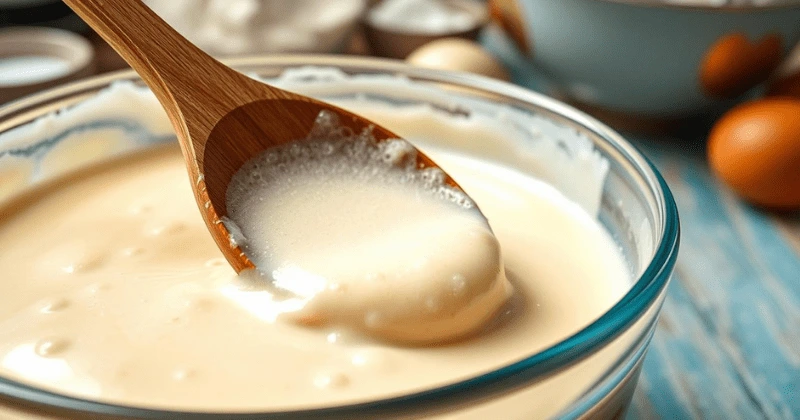
- Start with a thick, creamy batter that slowly pours from the bowl.
- Add small amounts of milk or flour to adjust the thickness as needed.
- Experiment with different flours to find your preferred consistency.
- Avoid over-mixing the batter, which can result in dense, tough pancakes.
“The perfect sourdough pancake batter should be thick enough to hold its shape, yet thin enough to pour easily from the bowl.”
Remember, finding the right batter thickness is all about balance. With a bit of practice and trying different things, you’ll make sourdough pancakes that are light, fluffy, and delicious.
Cooking Techniques for Fluffy Results
You need to control the heat and timing to make perfect, fluffy sourdough pancakes. This ensures your pancakes turn out just right.
Temperature Control
For the best results, cook your sourdough pancakes on medium-low heat. This gentle heat helps the pancakes rise inside while keeping the outside from burning. Aim for a temperature between 325°F and 350°F. Adding a small amount of butter can make them golden brown and crispy.
Timing Your Flips
Flip your pancakes when you see bubbles and the edges darken. Don’t flip them too much, as this can make them dense. Instead, flip each pancake and cook until it’s puffed and golden brown on the bottom.
“The secret to the perfect fluffy pancakes is all in the timing and temperature control. With a little practice, you’ll be cooking pancakes like a pro in no time!”
| Technique | Description |
|---|---|
| Temperature Control | Cook on medium-low heat (325°F to 350°F) for even browning and thorough cooking. |
| Timing Your Flips | Flip pancakes only once, when bubbles form on the surface and edges begin to darken. |
Mastering these cooking techniques will help you make fluffy pancakes every time. You’ll get them perfectly flipped with ease.
Troubleshooting Common Pancake Problems
Making perfect sourdough pancakes is a fun challenge, but it can also have its ups and downs. Don’t worry—we’ve got you covered with pancake troubleshooting tips for common issues.
One big problem is gummy, undercooked pancakes. Heat your skillet or griddle to fix this, and don’t flip too soon. Wait until they’re golden brown before flipping them.
Flat, dense pancakes can also be a problem. Check your recipe for leavening agents like baking soda or powder. Letting the batter rest can also help make them fluffy.
Uneven browning is another issue. Keep your heat steady, and don’t overcrowd the pan. This way, each pancake cooks evenly.
Using room-temperature ingredients and not overmixing the batter also helps. With practice and these tips, you’ll soon be a pancake pro!
“The key to perfect pancakes lies in mastering the art of patience and attention to detail.”
Creating Different Flavor Variations
Explore the world of sourdough pancakes by trying new flavours. Add sweet or savoury touches to make your breakfast memorable. This way, you can please everyone’s taste buds.
Sweet Options
Add fresh blueberries or ripe bananas to your batter for natural sweetness. For a decadent treat, mix in chocolate chips or nuts like walnuts. Each addition makes your pancakes unique and tasty.
Savory Combinations
Try something new with savoury sourdough pancakes. Add herbs, bacon, or cheese to the batter. Mix different flours like wheat and blue corn for exciting flavours.
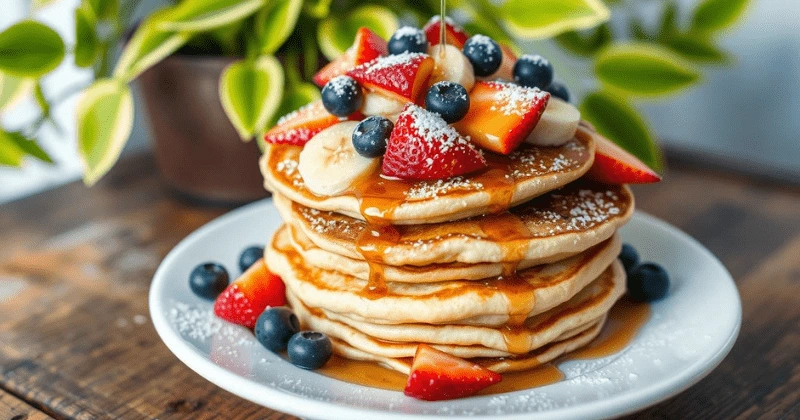
Sourdough pancakes are incredibly versatile. Whether you like them sweet or savoury, there’s always something new to try. Let your imagination run wild, and enjoy discovering new flavours.
Toppings and Serving Suggestions
Make your sourdough pancakes even better with tasty toppings and serving ideas. Begin with a classic: drizzle maple syrup and add creamy butter. This lets the sourdough’s tangy flavour stand out. Add fresh fruit like berries, bananas, or peaches for a burst of freshness.
Add whipped cream, toasted pecans, or walnuts for a decadent treat. For a savoury twist, try crispy bacon, sausage, or gravy.
| Topping | Description | Serving Suggestion |
|---|---|---|
| Maple Syrup | Rich, sweet, and indulgent | Drizzle generously over pancakes |
| Fresh Fruit | Berries, bananas, peaches, etc. | Top pancakes with sliced or whole fruit |
| Whipped Cream | Light, fluffy, and creamy | Dollop on top of pancakes |
| Nuts | Pecans, walnuts, almonds | Sprinkle over pancakes or make a topping |
| Savory Toppings | Bacon, sausage, gravy | Serve alongside or on top of pancakes |
There are countless ways to top and serve your sourdough pancakes. Try different flavours to find your favourite. Enjoy your delicious homemade pancakes!
Make-Ahead and Storage Tips
Sourdough pancakes aren’t just for mornings. With smart prep and storage, you can enjoy them anytime. For convenience, let’s look at the best ways to make, freeze, and reheat these treats.
Freezing Instructions
Sourdough pancakes freeze well and last up to 3 months. After cooking, cool them completely. Then, stack them with parchment paper in between to prevent sticking.
Please place them in an airtight container or resealable bag. Frozen pancakes are excellent for meal prep and quick breakfasts.
Reheating Methods
- Microwave: For quick reheating, place frozen pancakes on a microwave-safe plate. Heat in 10-20 second intervals until warm.
- Oven: Preheat to 350°F. Arrange frozen pancakes on a baking sheet. Reheat for 4-5 minutes, until warm and crispy.
- Toaster or Toaster Oven: Reheating pancakes in a toaster or oven brings back their crispness. Just toast until heated through.
These easy freezing and reheating tips let you enjoy homemade sourdough pancakes anytime. No need to start from scratch each time.
Leftover pancakes in the fridge last up to 4 days. They’re perfect for breakfast or snacks all week. With some planning and these tips, you’ll always have delicious pancakes ready.
Nutritional Benefits and Dietary Adaptations
Sourdough pancakes are a tasty and healthy breakfast choice. The fermentation process makes them easier to digest and more nutritious than regular pancakes.
Using whole grain flour like wheat or oat flour boosts the pancakes’ fibre, vitamins, and minerals. This makes your entire grain pancakes a healthier start to your day.
Swap dairy milk for almond, soy, or oat milk for a vegan diet. Flax or chia seeds can replace eggs, keeping the pancakes fluffy.
Those on a gluten-free diet can enjoy sourdough pancakes using gluten-free flour blends. This simple change lets everyone enjoy homemade sourdough pancakes, no matter their diet.
| Nutrition Facts | Per Serving |
|---|---|
| Calories | 132 |
| Carbohydrates | 18g |
| Protein | 4g |
| Fat | 5g (4g saturated) |
| Cholesterol | 12mg |
| Sodium | 194mg |
Embracing sourdough pancakes lets you have a tasty and nutritious breakfast. It meets your dietary needs and preferences.
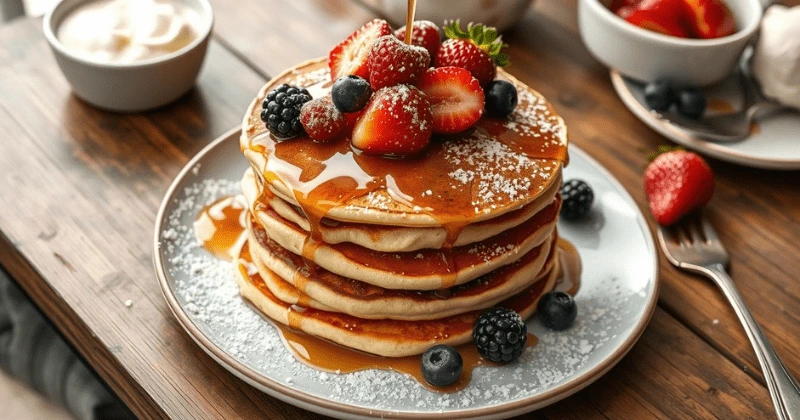
Converting Traditional Pancake Recipes to Sourdough
You can mix both if you love traditional pancakes but want to try sourdough. Just add sourdough starter to your favorite recipes. This way, you can enjoy sourdough pancakes while keeping the comfort of your old recipes.
Replace some flour and liquid with a sourdough starter to make a sourdough version. Use 1 cup of starter, 2 1/4 cups of flour, and 1 cup of warm water. Also, reduce other leavening agents since the starter will help your pancakes rise.
After mixing the ingredients, let the batter rest for 30 minutes to an hour. This time allows the sourdough culture to add tangy flavor and improve the pancake’s texture.
You’ll find the perfect mix of sourdough and pancake as you try different ratios. Adjust the flour, starter, and liquids to match your taste. The fun of making sourdough pancakes is finding what you like best.
“The secret to perfect sourdough pancakes is patience and a little experimentation. Trust the process, and you’ll be rewarded with fluffy, flavorful masterpieces.”
The trick to making sourdough pancakes is finding the right balance. With some creativity and experimentation, you can add sourdough’s bold flavors to your favorite pancake recipes, taking your breakfast to a new level.
Seasonal Variations and Special Occasions
Make the most of your sourdough pancakes by exploring seasonal flavors and celebrating special moments. Whether you’re in the mood for fall’s cozy tastes or summer’s bright flavors, these pancakes can be tailored for any event.
As fall arrives, add autumn’s essence to your pancakes. Pumpkin pancakes, made with pumpkin puree and warm spices, are a perfect fall treat. Enjoy them with maple syrup and toasted pecans for a luxurious brunch.
In summer, turn your pancakes into a refreshing delight. Mix fresh blueberries, raspberries, or mixed berries for a sweet surprise. Finish with whipped cream and powdered sugar for a delicious and photogenic brunch.
Sourdough pancakes are ideal for special occasions. Make heart-shaped pancakes for Valentine’s Day or festive pancakes for Christmas. You can even decorate them with edible flowers for a springtime brunch. Let your imagination run wild.
Think outside the box with your pancakes. Use them to create a breakfast sandwich with bacon, cheddar, and a fried egg. Or, for a sweet treat, build a pancake tower with fruit, whipped cream, and chocolate sauce.
Whether it’s a holiday or just a weekend, sourdough pancakes are a versatile base for your culinary dreams. Enjoy the changing seasons and create brunches that will impress everyone.
Expert Tips for Professional-Looking Results
With these tips, you can make your sourdough pancakes look amazing. First, heat a greased griddle or non-stick pan to cook evenly. Pour the batter from the same height for perfect pancake shapes.
Want to add color or texture? Sprinkle fresh berries or chocolate chips right after pouring. Use a thin, flexible spatula to flip the pancakes, gently keeping them soft and beautiful.
Serve your pancakes on warm plates for a cozy feel. This simple step keeps them warm and inviting. With some care, your kitchen can feel like your favorite brunch spot.
Learning the basics of food styling and cooking tips will help you showcase your sourdough pancake presentation and impress your loved ones with your breakfast skills.
FAQ
How long does sourdough pancake batter last?
Sourdough pancake batter can last 3-5 days when stored properly in the refrigerator. Its longevity depends on the starter’s activity and the freshness of the other ingredients. Keep the batter in an airtight container to retain optimal flavor and texture. Always check for any signs of spoilage before using to ensure your sourdough pancake creations remain delightful.
How long does sourdough bread take to mold?
Due to its acidic environment, sourdough bread, known for its natural fermentation process, resists mold longer than commercial bread. Depending on storage conditions, it can typically last 5-7 days before mold appears. Unlike the quick spoilage of certain baked goods like sourdough pancake batter, proper storage in a cool, dry place helps extend the bread’s freshness and prevent early decay.
Why are sourdough pancakes better?
Sourdough pancakes are superior due to their rich, tangy flavor and light, airy texture. The natural fermentation process enhances taste and improves digestibility by breaking down gluten and phytic acid. Packed with probiotics and nutrients, a sourdough pancake offers a healthier alternative to traditional options, making it both a flavorful and wholesome choice for breakfast enthusiasts.
How much protein is in sourdough pancakes?
A typical sourdough pancake contains around 4-6 grams of protein per serving, depending on the recipe, and additional ingredients like eggs or milk. The natural fermentation process enhances nutrient availability, making the protein more bioavailable. Consider incorporating Greek yogurt or nut flour into your sourdough pancake batter for a protein boost, creating a more balanced and nutritious meal.
Why are my sourdough pancakes tough?
A tough sourdough pancake often results from overmixing the batter, which develops excessive gluten and compromises the texture. Insufficient resting time for the sourdough starter can also lead to density issues. To achieve a tender sourdough pancake, gently fold the ingredients and allow adequate fermentation, ensuring a light, fluffy consistency with the perfect balance of chewiness and softness.
How long can sourdough rise?
Depending on temperature, hydration, and starter activity, sourdough can rise from 4 to 24 hours. A longer rise allows for more profound fermentation, enhancing flavor and texture. While this process applies to bread, even a sourdough pancake batter benefits from extended fermentation, creating a more robust tang and improved digestibility. Proper timing ensures the ideal balance of taste and structure.
Is sourdough resistant to mold?
Sourdough is relatively resistant to mold due to its natural acidity and the presence of lactic acid bacteria, which inhibit fungal growth. This resistance makes sourdough bread and even sourdough pancake batter more durable than commercially leavened products. However, improper storage in humid conditions can still lead to spoilage. Airtight containers and cool environments are key to prolonging freshness.
How do you know when sourdough bread is done?
Sourdough bread is done when it achieves a golden-brown crust and sounds hollow when tapped on the bottom. For precision, check the internal temperature; it should reach 200-205°F (93-96°C). Unlike a sourdough pancake, bread requires thorough baking to ensure a fully developed crumb. Allow it to cool completely before slicing to retain its structure and flavor.
How long does sourdough take to activate?
Sourdough takes 4 to 12 hours to activate, depending on the ambient temperature and the strength of the starter. Warmer environments speed up the process, while cooler ones slow it down. For recipes like a sourdough pancake, ensure the starter is bubbly and doubled in size before use. Proper activation guarantees optimal fermentation and a tangy, well-aerated result.

